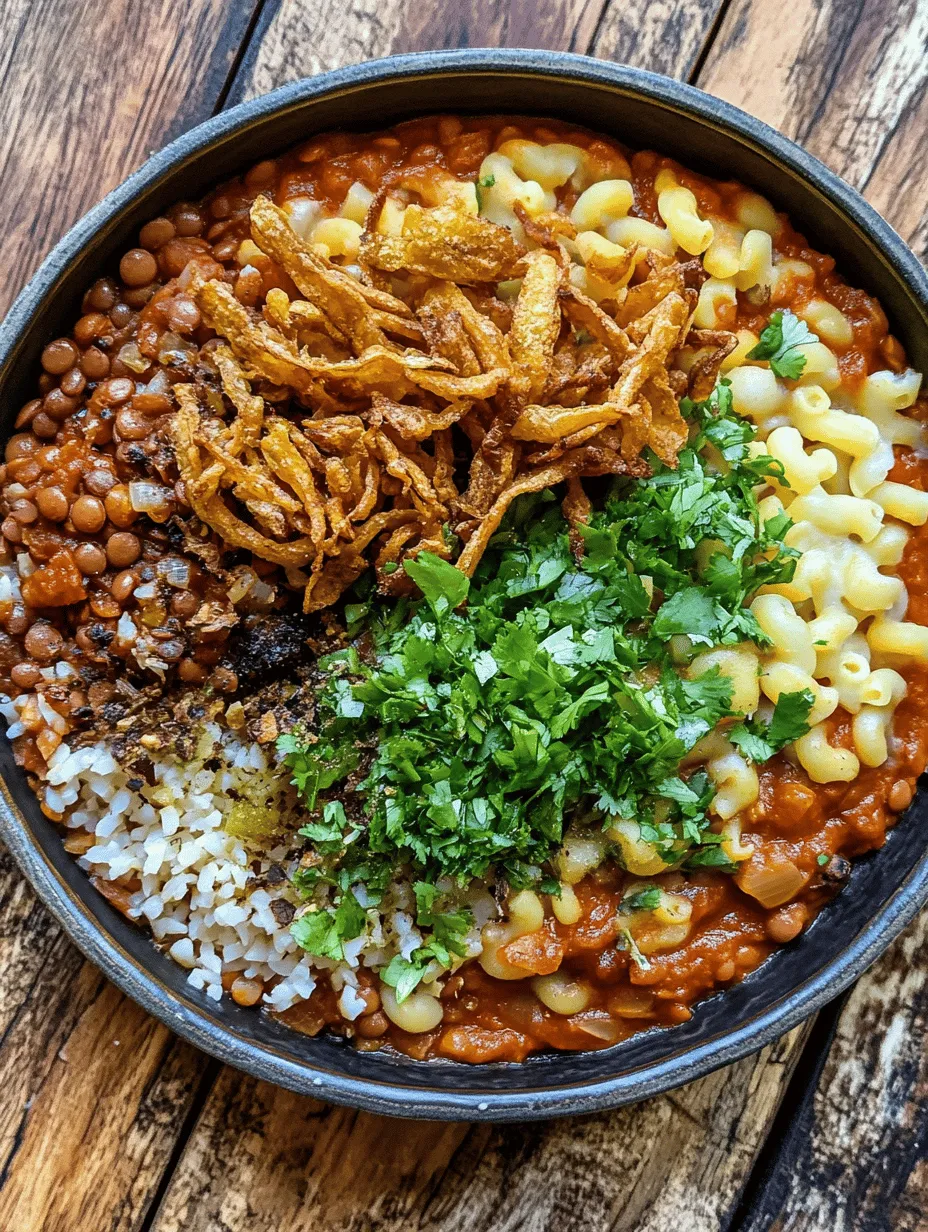Introduction
Koshari, often hailed as Egypt’s national dish, is a delicious and hearty meal that perfectly encapsulates the essence of Egyptian cuisine. This dish is a delightful melange of flavors and textures, combining staple ingredients such as lentils, rice, macaroni, and a tangy tomato sauce, all topped with crispy fried onions and a sprinkle of fresh cilantro. Koshari is not just a dish; it’s a cultural experience that resonates with locals and visitors alike. Its significance in everyday Egyptian life cannot be overstated, as it represents comfort food at its finest, often enjoyed by families and street vendors alike.
In recent years, Koshari has gained international acclaim, finding its way onto menus beyond Egypt’s borders. Food enthusiasts across the globe are discovering this vegetarian delight, which is not only delicious but also remarkably nutritious. As more people seek out unique culinary experiences, Koshari stands out as a dish worth savoring, showcasing the rich culinary heritage of Egypt.
Understanding Koshari: A Cultural Icon
Koshari’s roots can be traced back to the late 19th century, when it emerged as a popular street food in Cairo. It was initially created as a way to make use of leftover ingredients, showcasing the resourcefulness of the Egyptian people. Over the years, this humble dish has evolved into a beloved culinary staple, enjoyed by people from all walks of life. Koshari is often found in bustling street markets and local eateries, where vendors serve it hot, ready to satisfy the appetites of hungry patrons.
As a symbol of Egyptian street food, Koshari embodies the spirit of community and togetherness. It is often shared among family and friends, making it a dish that brings people together. The combination of flavors—earthy lentils, comforting rice, and tangy tomato sauce—creates a harmonious dish that is both satisfying and nourishing. Moreover, Koshari is an excellent source of protein, thanks to its lentils and rice, making it a nutritious choice for those seeking a wholesome meal.
The ingredients that comprise Koshari are not only delicious but also offer significant health benefits. Brown lentils are rich in protein and fiber, promoting digestive health and providing sustained energy. Rice serves as the base of the dish, providing a hearty texture that complements the other ingredients. Macaroni adds a comforting element, making Koshari a filling option for any meal. The spices used in Koshari—cumin, coriander, and paprika—enhance the flavor profile and contribute to the dish’s aromatic appeal. Finally, the tomato sauce ties everything together, infusing the dish with a rich and tangy taste that elevates it to new heights.
Ingredients Breakdown
To create an authentic and flavorful Koshari, each ingredient plays a crucial role in the overall dish. Here’s a closer look at the essential components that come together to make this iconic Egyptian meal:
– Brown Lentils: As a key ingredient, brown lentils provide a hearty source of protein and fiber. They not only add nutritional value but also a rich, earthy flavor that serves as the foundation of the dish. When cooked properly, lentils become tender and blend seamlessly with the other elements.
– Rice: The base of Koshari, rice adds a comforting texture that balances the dish. For the best results, long-grain rice is ideal, as it remains fluffy and separate when cooked. The rice absorbs the flavors of the spices and sauce, enhancing the overall taste experience.
– Macaroni: Adding a touch of familiarity, macaroni contributes to the comforting nature of Koshari. Its shape and texture create a delightful contrast with the other ingredients, ensuring a satisfying bite every time.
– Spices: The spice mix is crucial in defining the flavor profile of Koshari. Cumin brings warmth and depth, coriander adds a citrusy note, and paprika introduces a hint of smokiness. Together, these spices elevate the dish, transforming simple ingredients into a culinary delight.
– Tomato Sauce: Often referred to as the heart of Koshari, the tomato sauce is what brings all the components together. A well-seasoned sauce, made with fresh tomatoes and spices, adds acidity and richness, tying the dish together beautifully.
– Fried Onions: For a finishing touch, fried onions provide a crunchy texture and a savory richness that complements the other ingredients. Their caramelized flavor adds depth and enhances the overall experience of enjoying Koshari.
– Fresh Cilantro: A sprinkle of fresh cilantro not only adds a pop of color but also brings brightness to the dish. Its herbal notes contrast with the richness of the other components, creating a well-rounded flavor profile.
Preparation Steps: Crafting the Perfect Koshari
Creating the perfect Koshari involves careful preparation and attention to detail. Here’s a step-by-step guide on how to prepare the foundational elements of this delicious dish.
Detailed Preparation of Lentils
1. Rinse the Lentils: Start by measuring out the brown lentils. Place them in a fine-mesh strainer under cold running water and rinse thoroughly. This step removes any dust or impurities, ensuring your lentils are clean before cooking.
2. Soak (Optional): While soaking lentils is not mandatory, doing so can reduce cooking time and enhance digestibility. If you choose to soak, cover the lentils with water and let them sit for about 30 minutes. After soaking, drain and rinse again.
3. Cook the Lentils: In a medium-sized pot, add the rinsed lentils and cover them with fresh water. For every cup of lentils, use approximately three cups of water. Bring the pot to a boil, then reduce the heat to a simmer. Cook for about 15-20 minutes, or until the lentils are tender but still hold their shape. Be careful not to overcook them, as mushy lentils will not provide the desired texture in your Koshari.
4. Drain and Set Aside: Once cooked, drain any excess water from the lentils and set them aside. They will absorb flavor from the tomato sauce later, enhancing the dish’s overall taste.
Cooking Rice
1. Rinse the Rice: Similar to lentils, rinsing the rice is essential to remove excess starch, which can cause the rice to become gummy. Place the rice in a fine-mesh strainer and rinse under cold water until the water runs clear.
2. Boil the Water: In a separate pot, bring a generous amount of water to a boil. You will need about two cups of water for every cup of rice.
3. Cook the Rice: Once the water reaches a rolling boil, add the rinsed rice along with a pinch of salt. Stir briefly, then lower the heat and cover the pot with a tight-fitting lid. Allow the rice to simmer for about 15 minutes, or until all the water is absorbed. Avoid lifting the lid during this time, as it can disrupt the cooking process.
4. Fluff and Rest: Once the rice is cooked, remove the pot from heat and let it sit, covered, for an additional 5 minutes. This resting period allows the rice to steam, resulting in fluffy grains. After resting, fluff the rice with a fork to separate the grains.
With the lentils and rice prepared, you are on your way to crafting a delicious Koshari. The next steps will involve cooking the macaroni, preparing the tomato sauce, and combining all the elements to create this iconic Egyptian dish. Stay tuned for the continuation of this culinary journey, where we will delve deeper into the remaining ingredients and finalize your Koshari Delight.

Boiling Macaroni
To create the perfect Koshari, the first step involves boiling the macaroni to an ideal al dente consistency. Start by filling a large pot with water, adding a generous pinch of salt, and bringing it to a rolling boil. Once boiling, add the macaroni. Stir occasionally to prevent sticking. It’s crucial to follow the cooking time recommended on the package, typically around 7-9 minutes, but keep a close eye and taste a piece a minute before the time is up. The goal is a firm yet tender bite that holds up well when layered with the other components of the dish.
Once the macaroni reaches the desired texture, drain it in a colander and rinse briefly under cold water to stop the cooking process and remove excess starch. Set it aside to cool while you prepare the other elements of Koshari.
Frying Onions
Next, let’s turn our attention to the onions, which add a delightful crunch and flavor to the dish. Begin by slicing two medium onions thinly. The key to achieving the perfect golden-brown color is to use a combination of moderate heat and patience. Heat a generous amount of vegetable oil in a frying pan over medium heat. Once the oil is hot, add the sliced onions, stirring occasionally.
To prevent burning, keep the heat steady and allow the onions to caramelize slowly. This process can take around 10-15 minutes. Keep a close watch, as the onions can quickly go from perfectly brown to burnt. The goal here is to achieve a deep golden hue, which contributes both flavor and visual appeal to your Koshari. Once done, use a slotted spoon to remove the onions from the oil and place them onto a paper towel-lined plate to absorb excess oil.
Making the Tomato Sauce
Now it’s time to create the rich, flavorful tomato sauce that brings the Koshari together. In a medium saucepan, heat a tablespoon of olive oil over medium heat. Add two minced garlic cloves and sauté until fragrant, about 30 seconds. Next, add 400 grams of crushed tomatoes, followed by a teaspoon of cumin, a teaspoon of coriander, and salt and pepper to taste.
Bring the mixture to a gentle simmer, allowing the flavors to meld together beautifully. The simmering process is significant; it not only thickens the sauce but also deepens the flavor profile. Let it cook for about 15-20 minutes, stirring occasionally. If you prefer a slightly spicy kick, consider adding a pinch of cayenne pepper or red chili flakes at this stage. Once the sauce has thickened to your liking, remove it from the heat and set it aside.
Layering the Dish
Layering Koshari is an art that contributes to its visual appeal and flavor harmony. Start by placing a generous portion of cooked lentils at the bottom of your serving dish. Follow this with a layer of the macaroni. Next, spoon over the rich tomato sauce, ensuring an even distribution. Finally, top the dish with the crispy fried onions for that perfect finishing touch.
For an elegant presentation, consider using a large glass serving dish that showcases the vibrant layers. You can also garnish with chopped fresh parsley or a sprinkle of paprika for an extra pop of color. The final layer of fried onions not only adds crunch but also enhances the overall flavor of the dish, making it irresistible.
Serving Suggestions
In Egypt, Koshari is best enjoyed hot and served in generous portions. Traditionally, it is served in a large communal bowl, allowing everyone to help themselves. This dish is often accompanied by additional condiments that elevate the experience. A tangy vinegar or garlic sauce, known as “dakka,” is a popular addition that complements the hearty flavors of Koshari.
For those looking to enhance the meal further, consider serving it alongside a crisp green salad or some pickled vegetables, which add a refreshing contrast to the rich Koshari. Street vendors often serve Koshari with a side of spicy sauce, allowing diners to customize the heat level to their taste. When enjoyed in this manner, Koshari becomes not just a meal but an experience, rich in textures and flavors.
Health Benefits of Koshari
Koshari is not only delicious but also a nutritious option for those looking for a wholesome meal. The dish is primarily made up of lentils, rice, and macaroni, providing a well-rounded nutritional profile. The lentils are an excellent source of plant-based protein, making Koshari a great choice for vegetarians and vegans.
Additionally, the fiber content from the lentils and macaroni aids in digestion, promoting gut health. This makes Koshari a filling dish that can help keep you satisfied longer, reducing the likelihood of unhealthy snacking. Given its affordability and the availability of ingredients, Koshari stands out as a low-cost, high-nutrition meal option for families and individuals alike.
Koshari Variations and Regional Twists
While Koshari has its roots in Egyptian cuisine, regional adaptations can be found throughout the country. In some areas, you might encounter variations that incorporate additional ingredients like chickpeas or fried eggplant, adding unique flavors and textures.
Vegetarian and vegan alternatives are also common, with chefs experimenting by substituting the traditional pasta with whole grain options or using quinoa for a different twist. Some modern chefs have begun to use gourmet ingredients, such as truffle oil or flavored oils, to elevate the dish for fine dining experiences. These creative twists make Koshari an evolving dish that can cater to various palates.
Conclusion
Koshari is much more than just a meal; it is a cultural staple that embodies the heart and soul of Egyptian cuisine. This beloved dish showcases a delightful combination of flavors and textures, making it a favorite among locals and visitors alike. Its simplicity and versatility invite anyone to try making it at home, celebrating its rich flavors and comforting nature.
As you embark on your culinary journey with Koshari, remember that the beauty of this dish lies not only in its ingredients but also in the love and tradition that goes into preparing it. So gather your ingredients, invite friends or family to join in the preparation, and enjoy a delightful taste of Egypt right in your kitchen.



